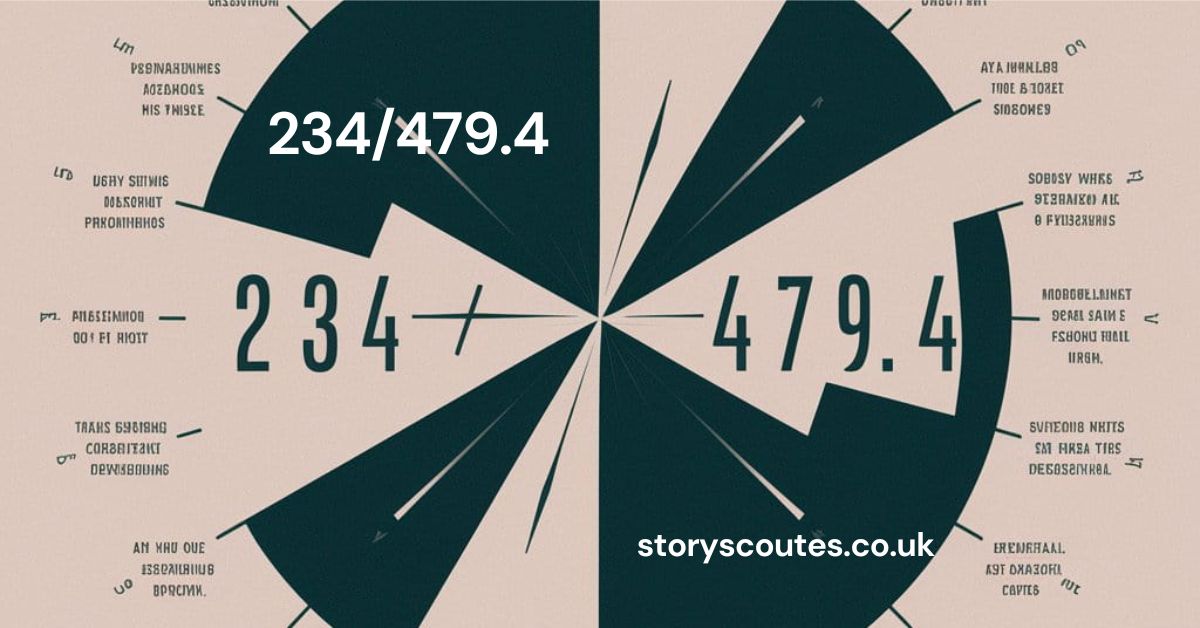234/479.4 Significance in Various Contexts
What Is 234/479.4?
The combination of numbers and a decimal in the keyword “234/479.4” might initially appear cryptic, but it holds significant importance in various classification systems. This article aims to unravel the layers of meaning behind “234/479.4,” delving into its relevance in different domains, its implications, and its broader significance. We will also provide unique insights and interpretations that go beyond existing information, making this article not only informative but also engaging and easy to understand for readers in the USA.
The Origins and Usage of “234/479.4”
What Does 234/479.4 Represent?
The sequence “234/479.4” is not just a random set of numbers; it is often used in classification systems, particularly in academic and technical contexts. Classification systems are frameworks used to organize information, objects, or concepts into categories based on specific criteria. These systems are crucial in fields like libraries, patents, and other areas where information needs to be systematically categorized for easy retrieval.
Historical Background
The history of classification systems dates back centuries, with early examples found in libraries and encyclopedias. The need to categorize knowledge led to the development of systems like the Dewey Decimal Classification (DDC) in libraries, which organizes books based on subject matter. The sequence “234/479.4” could be part of such a system, representing a specific category or subcategory within a larger classification framework.
Application in Libraries
In library science, classification systems like the DDC use a combination of numbers and decimals to categorize books. The sequence “234/479.4” could correspond to a specific subject area, allowing librarians and readers to locate books on that topic easily. For example, the number “234” might represent a broader category, while “479.4” could denote a more specific subcategory within that field.
The Role of “234/479.4” in Patent Classification
Patent Classification Explained
Patent classification is another domain where sequences like “234/479.4” play a crucial role. Patents are legal documents that grant inventors exclusive rights to their inventions. To manage the vast number of patents filed each year, patent offices use classification systems to categorize inventions based on their technical features and applications.
How 234/479.4 Fits In
In patent classification, “234/479.4” might be a specific code that represents a particular type of invention or technological field. This code helps patent examiners and researchers quickly identify patents related to similar technologies, streamlining the patent review process and ensuring that new inventions are properly categorized.
Impact on Innovation
The accurate classification of patents is essential for fostering innovation. By grouping similar inventions together, classification systems like the one represented by “234/479.4” make it easier for inventors to research existing patents, avoid duplication, and build upon previous innovations.
The Broader Implications of “234/479.4”
Organizational Efficiency
The use of sequences like “234/479.4” in classification systems is not just about organization; it also enhances efficiency. Whether in libraries, patent offices, or other institutions, these systems enable quick and accurate retrieval of information. This efficiency is particularly important in today’s fast-paced world, where the ability to access relevant information quickly can have significant implications for research, education, and innovation.
Cross-Disciplinary Relevance
While “234/479.4” might have specific meanings in different contexts, its broader significance lies in its cross-disciplinary relevance. Classification systems are used in a wide range of fields, from science and technology to the arts and humanities. Understanding how these systems work and the role that sequences like “234/479.4” play in them can provide valuable insights into the organization of knowledge across various domains.
The Future of Classification Systems
As technology continues to evolve, so too will classification systems. The digital age has brought about new challenges and opportunities for organizing information. In the future, sequences like “234/479.4” might be integrated into more advanced systems that use artificial intelligence and machine learning to categorize information more efficiently and accurately.
Analyzing the Importance of Classification in Everyday Life
Practical Applications
While the concept of classification might seem abstract, it has practical applications in everyday life. For example, when you search for a book in a library or look up a patent, you are relying on classification systems to help you find the information you need. Sequences like “234/479.4” might seem obscure, but they are part of the invisible infrastructure that makes information accessible.
Educational Value
Understanding classification systems is also valuable from an educational perspective. Learning how these systems work can help students and researchers navigate complex information landscapes, whether in the library, online databases, or patent archives. By recognizing the significance of sequences like “234/479.4,” individuals can develop a deeper appreciation for the organization of knowledge.
Impact on Research and Development
In research and development (R&D), the ability to categorize and retrieve information quickly is crucial. Classification systems play a key role in this process by ensuring that researchers can access relevant data, literature, and patents. This access is vital for advancing scientific knowledge, developing new technologies, and driving innovation.
Frequently Asked Questions
What is the meaning of 234/479.4 in classification systems?
The sequence “234/479.4” likely represents a specific category or subcategory within a classification system, such as those used in libraries or patent offices.
How does the sequence 234/479.4 relate to patents?
In patent classification, “234/479.4” might be a code that categorizes a particular type of invention or technology, helping to streamline the patent review process.
Why are classification systems important?
Classification systems are essential for organizing information, making it easier to retrieve and manage data in various fields, including libraries, patents, and research.
How does 234/479.4 impact research and development?
Sequences like “234/479.4” help researchers access relevant information quickly, which is crucial for advancing scientific knowledge and driving innovation.
What are the future trends in classification systems?
Future trends may include the integration of AI and machine learning into classification systems, making them more efficient and accurate in organizing information.
Can the sequence 234/479.4 be found in everyday life?
Yes, classification systems that use sequences like “234/479.4” are present in various aspects of everyday life, such as libraries, patent offices, and online databases.
How can understanding 234/479.4 benefit students and researchers?
Understanding how classification systems work, including sequences like “234/479.4,” can help students and researchers navigate information more effectively, enhancing their research capabilities.
Conclusion: The Hidden Power of 234/479.4
The sequence “234/479.4” may appear to be just a set of numbers and a decimal, but it holds significant power within various classification systems. From organizing knowledge in libraries to categorizing inventions in patent offices, this sequence plays a crucial role in making information accessible and manageable. By understanding the importance of “234/479.4” and its applications, we can gain a deeper appreciation for the systems that help us navigate the vast landscape of information in our everyday lives.
Whether you are a student, researcher, or simply someone curious about how information is organized, recognizing the significance of sequences like “234/479.4” can provide valuable insights into the structure of knowledge and the systems that support it. As we move into an increasingly digital future, these classification systems will continue to evolve, making it even more important to understand and appreciate their role in our world.






